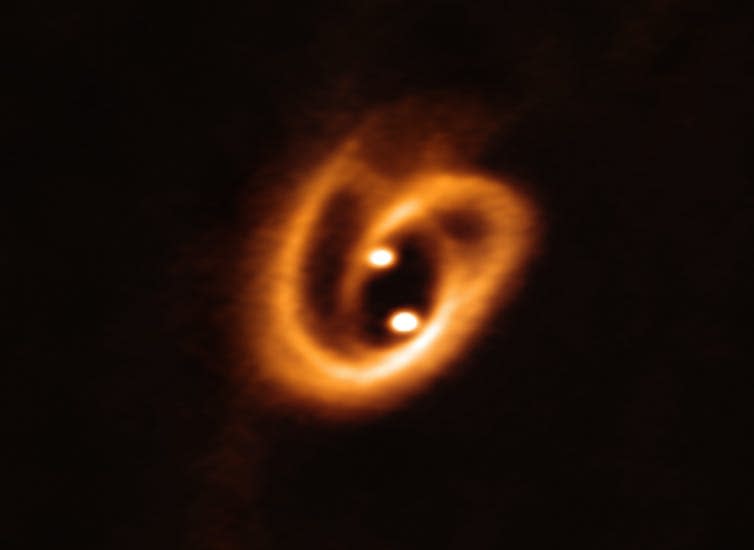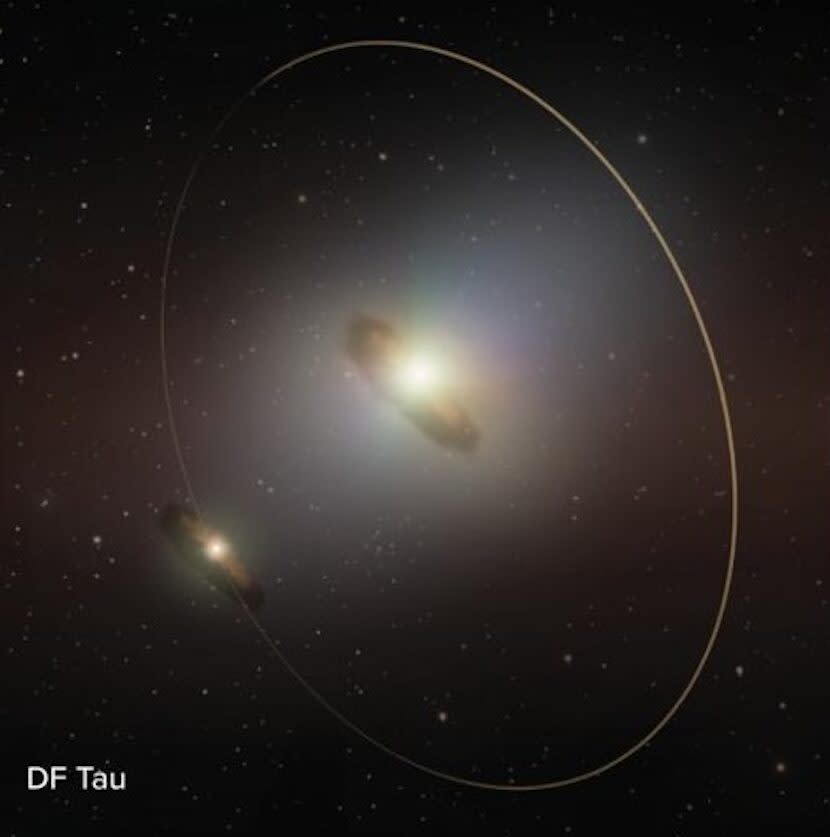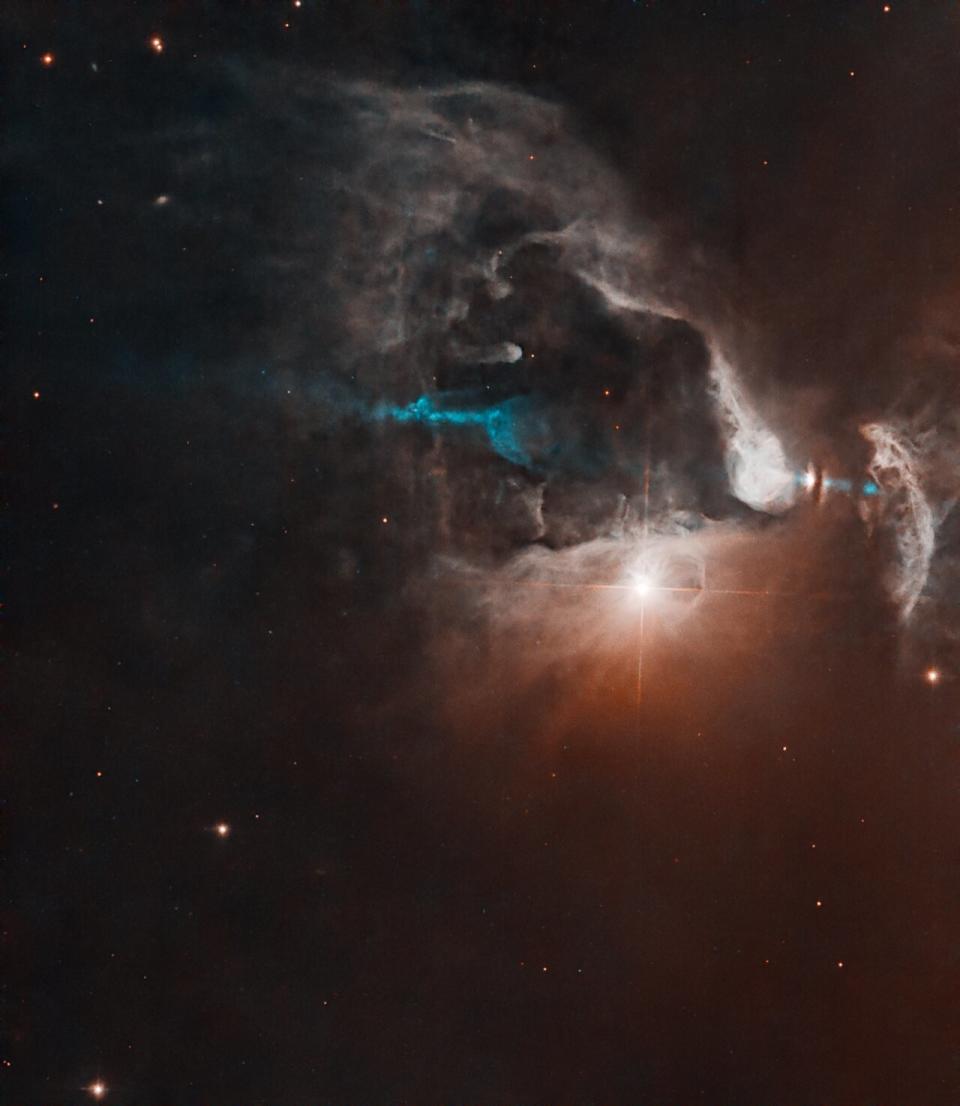Astronomers have gained new insight into the formation of planets around twin stars that orbit each other.
Despite the fact that we are most familiar with planets orbiting a single central star – such as the arrangement of our Solar System – more than 50% of the stars in the cosmos exist in a binary star system, meaning they have a companion star. These binary star systems can also have planets around them that either orbit one of the stars in a ‘circumstellar orbit’, or both stars orbit in a much wider ‘circular orbit’.
Using the Atacama Large Millimeter/submillimeter Array (ALMA) – made from a combination of 66 radio telescopes in northern Chile – and the Keck II 10-meter telescope in Hawaii, astronomers have collected data from two twin star systems. What they discovered could transform our understanding of the conditions that can promote or hinder such planet formation in binary systems.
Related: Just like in the 90s, double stars are back in fashion
Are two stars better than one for the birth of a planet?
The formation of double stars is not much different from the formation of single stars. These bodies form when dense clouds of cool, interstellar gas form overly dense patches that gather more mass and eventually collapse under their own gravity, giving birth to a stellar child called a “protostar.”
This protostar continues to accumulate material from its prenatal cocoon of gas and dust until it gains enough mass to initiate nuclear fusion of hydrogen to helium in its core, the process that defines a main sequence star. Importantly, some of these interstellar clouds are so large that two or even three main sequence stars can form within them.
The material left over from that cloud of gas and dust after the formation of these stars then surrounds them as what astronomers call a “protoplanetary disk.” As the name suggests, planets form from these disks. Like the planets themselves, the disks can be circumstellar, surrounding just one star, or circular, surrounding the entire system.

Scientists are currently unaware of the factors that allow these disks to persist long enough for planets to form, nor are they sure what ultimately causes the disks to disappear. It turns out that circumstellar disks in pre-main sequence protostar binary systems could be the ideal laboratories to investigate these questions.
Properties of these early disks, such as their sizes, substructures, and even their slopes (compared to features of protostars such as rotational speed and magnetic field strength) can reveal details of the complex interactions that shape such planet birth environments.
Furthermore, the sheer ubiquity of multi-star systems in the universe means that studying planet formation around twin stars is crucial to understanding this process at a deeper level.


One of the binary systems the team focused on with ALMA and Keck II was DF Tau, made of two protostars with a mass of about 0.6 times that of the Sun, located about 150 light-years from Earth in the star-forming region of Taurus.
DF Tau’s two stars are separated by a distance equal to about 14 times the distance between Earth and the Sun; it takes about 44 Earth years to complete their very elongated orbits.
Fascinatingly, ALMA discovered that the interstellar cloud responsible for creating these stars had split into two circumstellar disks. One is magnetically connected to the central star, DF Tau A, actively feeding it with material to facilitate its growth. The other appears to have become separated from the other star, DF Tau B. The central part of the disk appears to have been eroded as the young star rotates rapidly.
This suggested to the team that there could be a connection between the rotation of young stars and the magnetic locking of disks to them, and thus the early spreading of disks. Furthermore, it appears that misalignments between DF Tau’s orbit, its surrounding disks, and the stars’ obliquities could affect the overall evolution of the disk.


The second binary system the team focused on was the very young, 2.8 million year old FO Tau system (for context, remember that the Solar System is 4.6 million years old). billion years old).
This system is also located about 450 light years away from us. The stars, FO Tau A and B, are in a more circular orbit than that of DF Tau. They are also further apart, with FO Tau B orbiting FO Tau A at a distance equal to about 22 times the distance between Earth and the Sun.
Using ALMA, the astronomers discovered that FO Tau’s disks are aligned with the orbit of this binary star system. Both stars exhibit rotation rates on the slower side, and the two circumstellar disks remain magnetically linked to their protostars. This indicates that systems like FO Tau, with slower stars and more circular orbits, may be better suited to planetary body formation around both stellar components than fast systems with elongated orbits.
RELATED STORIES:
– A new trove of Gaia data will reveal the Milky Way’s dark past and future
– The newly discovered alien planet has nuclear fusion at its core
– The Gaia star-mapping spacecraft sees a pair of Jupiter-like planets
ALMA observations of other single and binary disks have revealed complex substructures within the disks, including features such as spiral patterns, holes and ring formations.
Although these structures are not currently visible for DF Tau and FO Tau, determining the more large-scale features in these two close binary systems has significantly advanced our understanding of planet formation environments.
The team’s results were revealed at the 244th meeting of the American Astronomical Society (AAS).